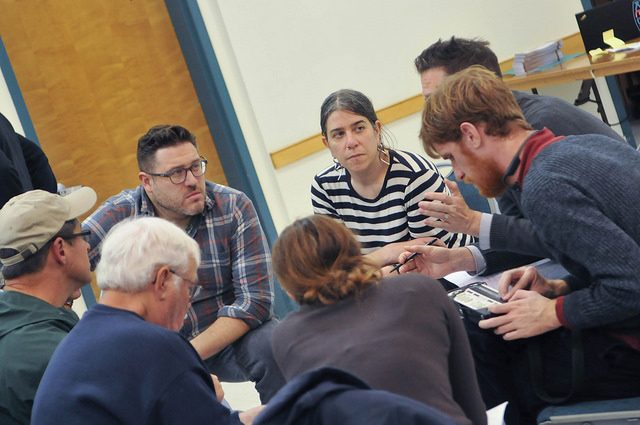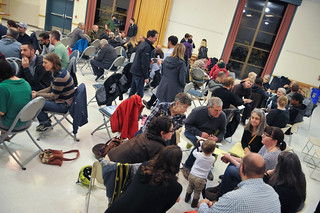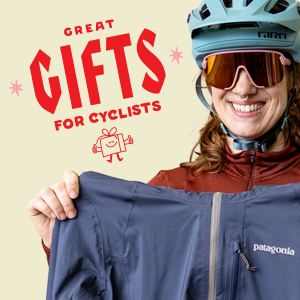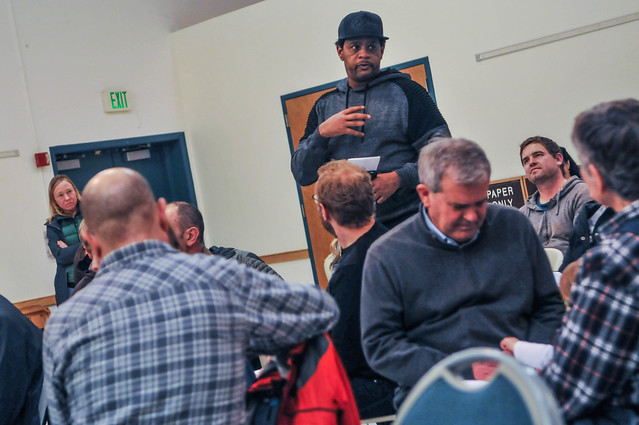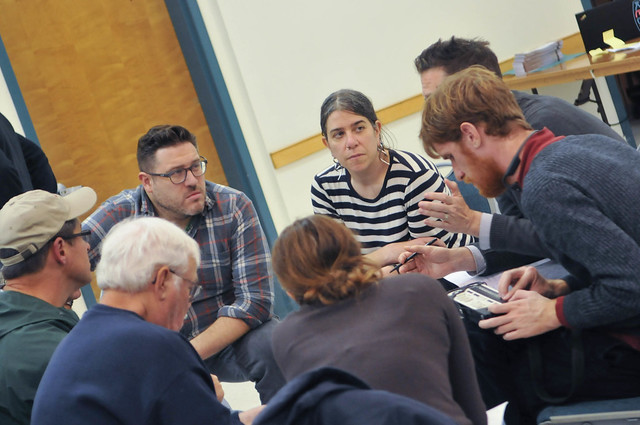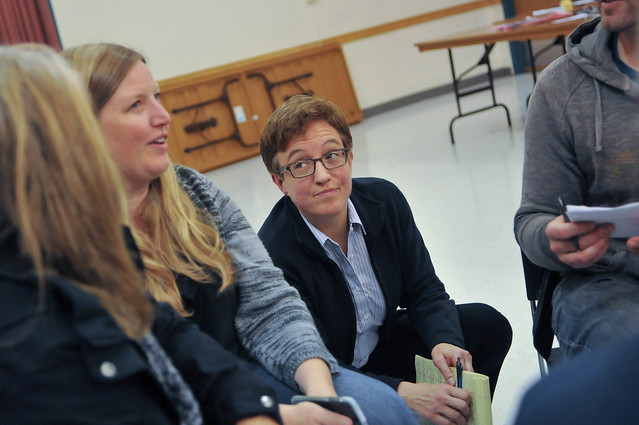About 75 people packed into the St. Johns Community Center on a rainy Monday night because they want the streets in front of their homes, schools and businesses to be safer and more humane.
The event, hosted by the St. Johns Neighborhood Association’s Safety and Livability Team, was scheduled before the death of a bicycle rider on the St. Johns Bridge late last month; but that tragedy has given even greater urgency to the concerns expressed last night.
Like many areas of Portland, St. Johns residents are fed-up with their streets being dominated by people who drive too fast and cut-through their neighborhoods to avoid congestion. Another issue on the minds of many last night was how their part of the city is hemmed in by large arterial streets managed by the Oregon Department of Transportation to prioritize freight traffic at the expense of everything else.
“Trucks drive fast past homes and crosswalks,” someone scrawled on a piece of paper that was turned in after the meeting. “And the road is too small for them… Residents don’t open their windows because of the fumes!”
Among the attendees were Oregon House Speaker Tina Kotek (a north Portland resident), St. Johns Neighborhood Association Safety and Livability Team Chair Travis Parker, Oregon Department of Transportation Metro West Area Manager Ana Jovanovic, and Portland Bureau of Transportation Active Transportation and Safety Division Manager Margi Bradway. All but the ODOT staffer gave brief presentations and took questions from the audience. After that, people were asked to write down issues of concern and then discuss them with others in a group exercise. The meeting ended after a representative from each group stood up and shared a summary of their discussion.
Here’s how the presentations went…

PBOT’s Bradway focused on the city’s Vision Zero efforts. At the outset of her talk, she tried to connect with the audience by sharing how much city staff cares about traffic safety. “I get choked up talking about this,” she said, “I want you to know there is not a dry eye on my Safe Routes to School staff when a kid gets hit on the way to school.” Bradway was referring to Bradley Fortner-Trujillo, a 15-year old who was nearly killed back in August by someone driving a truck as he attempted to cross Columbia Blvd near a middle school.
“We’re trying to tackle this issue, but we’re facing an uphill battle. The numbers are going in the wrong direction.”
— Margi Bradway, PBOT
Bradway added that this year has been “particularly tough” for PBOT morale because we’ve had 37 traffic fatalities, “the highest any of us can remember.” “We’re trying to tackle this issue, but we’re facing an uphill battle,” she said. “The numbers are going in the wrong direction.”
But there’s also good news on reducing speeds and Safe Routes to School.
Bradway reported that the city’s new photo radar camera program is “going really well.” The cameras are generating fewer tickets than expected which means people are slowing down. PBOT plans to roll out a new set of cameras every six months. Also on the speeding front, ODOT has officially granted PBOT permission to streamline the onerous process of requesting lower speed limits (something the state controls, even on city-owned roads). We reported on this effort in August and Bradway said they are moving forward with a pilot process with ODOT’s support. PBOT will test their new speed limit reduction request methodology on non-ODOT arterials.
Advertisement
Bradway also shared that PBOT is prepping a $13 million citywide investment in the Safe Routes to Schools program. Thanks to an $8 million infusion from the gas tax which PBOT leveraged into $5 million additional dollars, Bradway called it the city’s “biggest Safe Routes to School investment ever.”
A hopeful presentation slammed back into reality once the audience had a chance to respond. When someone asked about reducing speeds on Columbia Blvd where that 15-year-old boy was hit, Bradway acknowledged that ODOT won’t let them reduce the speed limit because freight has the priority. Bradway said that figuring out how “we can have safety and mobility coexist” is a central challenge of Vision Zero. “Those are tough conversations,” she said.
Another audience member stood up to express his anger and fear that the city “allows” people to park large motor vehicles too close to corners, which makes it hard to walk across the street in front of his house. “I’m playing ‘Frogger’ every day!” he said to a loud round of cheers. “I have to dash across the street because I can’t see around them. As soon as you step out there’s a car coming at you at 40 miles per hour!”
Bradway thanked the man for bringing up the issue, but didn’t have a very satisfying answer. “Like the mobility [freight] and safety conversation,” she said. “We’re having this tradeoff between parking and safety. We’re having those conversations internally and working on our policies.”
“To say that ODOT won’t do anything about Columbia because they want to prioritize freight is insane. People are dying.”
— Travis Parker, St. Johns Neighborhood Association
The neighborhood perspective continued when Parker shared some of his work. Parker is a dedicated volunteer who has made safer streets a personal crusade. Following that tragic collision back in August, Parker was “shocked” to learn there are 200 households separated from the rest of St. Johns because they live north of Columbia Blvd — a high-speed arterial that’s a designated freight route and has very few safe crossings. He shared images of the Midway footbridge over Columbia near George Middle School and explained most people don’t use it because it’s not maintained and isn’t easy to use. “This is something that needs to be fixed,” he said. “Immediately.”
Parker was visibly frustrated with ODOT’s defense of freight traffic on Columbia. “They’re putting freight first, which isn’t putting drivers in their cars or pedestrians or cyclists first… To say that ODOT won’t do anything about Columbia because they want to prioritize freight is insane. People are dying. If you don’t change that, we’re going to have another high school kid get hit.”
Parker mentioned the St. Johns Bridge briefly, saying his preference is to calm traffic and lower speeds. (Parker and others are currently meeting and strategizing about the St. Johns Bridge. We’ll cover those efforts in a future post.)
After Parker it was Oregon House Speaker Tina Kotek’s turn to address the crowd. Coming right after Parker’s comments, Kotek reinforced the dominance of freight from the state’s perspective: “When you’re on a freight route it’s very difficult to change that… We will continue to have freight on our roads,” she said. Kotek, who lives in the nearby Kenton neighborhood, alluded to the upcoming transportation funding package that will be proposed in the 2017 legislative session. She said part of any new revenue from that package will build infrastructure for safer biking and walking. “As St. Johns continues to grow, we have to continue to do more to have safety and also have freight movement. I will do what I can to advocate ODOT.”
Kotek also made a few comments about switching ownership of Portland’s “orphan highways” away from ODOT and to PBOT (a.k.a. jurisdictional transfer). Kotek said the state would like to do that but it’s a question of financing. PBOT doesn’t want the roads unless they’re in good condition so ODOT has to pour money into them before any transfer can take place. “We were successful with Sandy [a street that used to be owned by ODOT but is not under PBOT control],” Kotek said optimistically, “and we’d like to do that on Lombard as well.”
After her remarks Kotek listened and took notes as everyone participated in a group exercise. In small circles, people got to know their neighbors and discussed their top traffic safety concerns. Not suprisingly speeding, cut-through traffic, and freight were mentioned by several groups. Related to freight, many people in St. Johns are concerned about how diesel engines lead to dirty air. Another issue that was mentioned is the lack of a safe cycling connection between St. Johns and downtown Portland. Also mentioned in the groups: the growing impact of Waze on cut-through traffic, the need for light rail to St. Johns, a new freight-only bridge, and the feeling that the sharrows and sidewalk on the St. Johns Bridge are “absolutely deadly.”
At the end of the meeting, longtime resident and activist Shamus Lynsky said his growing neighborhood has been left without enough mobility choices. “We’re not doing enough to relieve the congestion because we don’t have viable transit or active transportation options, so people are forced into their cars.”
— Jonathan Maus, (503) 706-8804 – jonathan@bikeportland.org
BikePortland is supported by the community (that means you!). Please become a subscriber or make a donation today.
